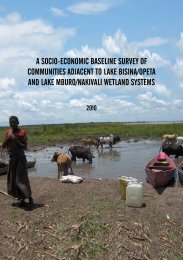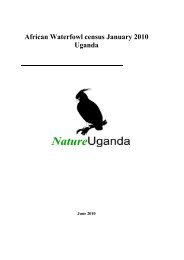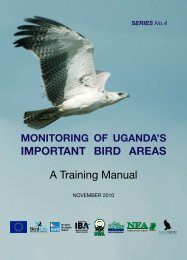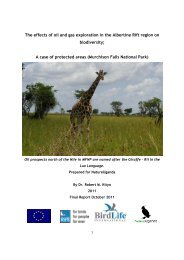Status and Trends 2009 - Nature Uganda
Status and Trends 2009 - Nature Uganda
Status and Trends 2009 - Nature Uganda
You also want an ePaper? Increase the reach of your titles
YUMPU automatically turns print PDFs into web optimized ePapers that Google loves.
Executive summary<br />
The four institutions alongside <strong>Nature</strong>Ug<strong>and</strong>a that are helping in monitoring IBAs are Ug<strong>and</strong>a Wildlife<br />
Authority (UWA), National Forest Authority (NFA), Wetl<strong>and</strong>s Management Department (WMD) <strong>and</strong><br />
National Biodiversity Data Bank (NBDB). These institutions help in management, monitoring <strong>and</strong><br />
research through various departments. The units involved in information management <strong>and</strong> community<br />
conservation are extremely vital to the processes of IBA monitoring. The community conservation programmes<br />
comprise revenue sharing projects, resource utilization, community tourism, conservation education <strong>and</strong><br />
creation of institutional linkages.<br />
These institutions have accepted to apply the global monitoring framework for IBAs which was customised for<br />
Ug<strong>and</strong>a. UWA is applying this for the second year while NFA <strong>and</strong> WMD have been just introduced to the model.<br />
However this simple data capturing format summarizes the variables as State, Pressure <strong>and</strong> Response which<br />
all contribute to the resultant trend analyses.<br />
The year 2001 is used as a baseline for which data is available. It should also be noted that although data for<br />
the 30 IBAs were available then, the 2008 analyses took care of only 22 IBAs <strong>and</strong> an additional two that were<br />
added later onto the list, making a total of 24 IBAs whose data were analyzed. Now in <strong>2009</strong>, 31 of the total 33<br />
IBAs have been included here in the analyses. The general trend has been maintained at just above moderate<br />
conditions. Interestingly the conditions showed a general slight decline from 2001 to 2008 confirmed by decline<br />
from 2.37±0.14 to 2.12±0.11 (Mean±SEM) when the analyses were done. This has however started to show<br />
an improvement of 2.19±0.12 (Mean±SEM). It should be noted that even with this improvement, the combined<br />
analyses do not reach the baseline level yet.<br />
The general trend of pressure in all IBAs have been rising steadily with a mean score of -1.2±0.15 in 2008 <strong>and</strong><br />
this has improved in <strong>2009</strong> with a mean score of -0.84±0.15 (Mean±SEM). The pressures in all IBAs if possible<br />
should be reduced to zero. It should be understood clearly that the trends are well explained over longer periods<br />
of time. This therefore means that the drop in pressures in <strong>2009</strong> should be taken with caution since a near<br />
future assessment may reflect a different scenario. However, <strong>2009</strong> assessment does reflect an improvement.<br />
The overall trend in responses is impressive however there are some IBAs that still do not have management<br />
plans (e.g. Doho Rice Scheme, Lake Opeta, Lake Nakuwa <strong>and</strong> Lutoboka Point) <strong>and</strong> some are now out of date (e.g.<br />
Lutembe Bay <strong>and</strong> Nabajjuzi Swamp). The sites are all at different levels of implementing conservation activities.<br />
In 2008, the overall conservation processes in all the IBAs registered significant progress with 2.36±0.17 <strong>and</strong> a<br />
slight decline in <strong>2009</strong> with score of 2.26 ±0.13 (Mean±SEM). This is still good since the score is above average.<br />
A lot more work is therefore still needed to reduce the threats status further such that the conditions <strong>and</strong> quality<br />
of the habitats are favourable to the biodiversity within them.<br />
The status of National Parks <strong>and</strong> Wildlife Reserves remained more or less similar up to 2008 <strong>and</strong> a slight<br />
improvement in <strong>2009</strong>. The condition of Forest Reserves has continued to have a steady decline through the<br />
years (2001, 2008 <strong>and</strong> <strong>2009</strong> have all registered declines. The conditions of the wetl<strong>and</strong> IBAs also have declined<br />
through the years except for a slight improvement in <strong>2009</strong>.<br />
Threats in National Parks/ Wildlife Reserves have for a long time been maintained at medium till 2008 <strong>and</strong><br />
this dropped in <strong>2009</strong>. Forest Reserves are below medium <strong>and</strong> with the gentlest rise of the three classes. This<br />
means that, in terms of effect, the Forest Reserves are still experiencing relatively minimal threats when spread<br />
throughout the sites. Threats in wetl<strong>and</strong> IBAs are the most important of the three in terms of conservation<br />
action. This is because the mean scores for wetl<strong>and</strong> threats rate highest <strong>and</strong> above the medium point <strong>and</strong> so<br />
efforts to improve the situation are needed.<br />
Response trends in National Parks <strong>and</strong> Wildlife Reserves are the most encouraging of the three management<br />
categories. This is because all the PAs have some level of protection <strong>and</strong> with significant levels conservation<br />
activities. Forest Reserves follow a similar scenario as PAs in <strong>2009</strong>. This means that, in terms of conservation<br />
activities, protection status <strong>and</strong> management planning, the Forest Reserves are rated second to National Parks<br />
<strong>and</strong> better than the IBAs in the wetl<strong>and</strong> habitats. Responses levels (conservation efforts) in wetl<strong>and</strong> IBAs are still<br />
low. This registered tremendous change by 2006 when many sites were designated as Ramsar sites.









